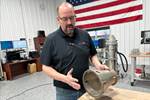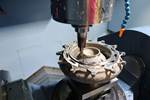6 Ways Additive Affects Machining
Machining is part of additive manufacturing, but the problems, pacing and possibilities of machining are all affected by their interaction with AM. Here are some of the ways machining changes when metal 3D printing is one of its drivers.
-
In laser powder bed fusion, the stock in need of machining is a safeguard against costly failure, helping to ensure successful builds on the first try.

An additive manufactured part being completed via five-axis machining at Cumberland Additive. Photo courtesy of Cumberland.
- Downstream machining has to preserve the high value of parts made additively. For this reason, don’t call it mere postprocessing.
- Because of the different pace and the need to take care with valuable parts, a different kind of temperament suits the machinists in an additive shop.
- The promise of AM for distributed manufacturing leads to CNC programming being performed remotely.
- Machining to separate parts from their build plate can be a challenging wire EDM operation, made even more challenging when it comes to EDM for part removal from very large build plates.
- Additive is bringing new possibilities to cutting tools and even to the machine tool itself.
Related Content
-
Top 10 Additive Manufacturing Stories of 2023
Laser powder bed fusion, proprietary AM processes, machining and more made our list of top 10 articles and videos by pageviews this year.
-
Zeda AM Production Plant in Ohio Now Open — Thoughts on the New Facility
73,000-square-foot metal powder bed fusion plant includes extensive machining capability plus separate operational models for serving medical versus other businesses.
-
Additive Manufacturing Is Subtractive, Too: How CNC Machining Integrates With AM (Includes Video)
For Keselowski Advanced Manufacturing, succeeding with laser powder bed fusion as a production process means developing a machine shop that is responsive to, and moves at the pacing of, metal 3D printing.











